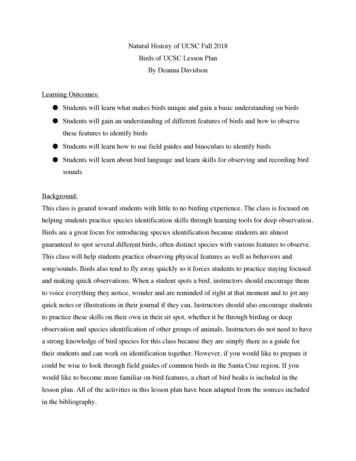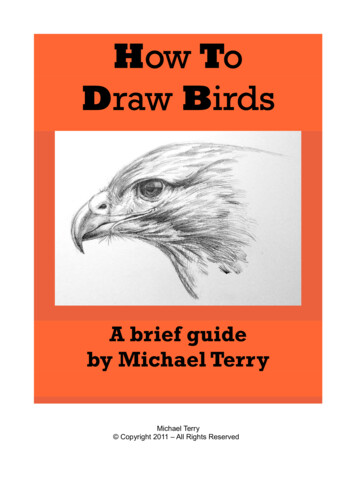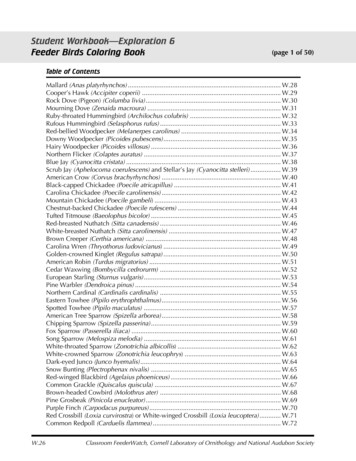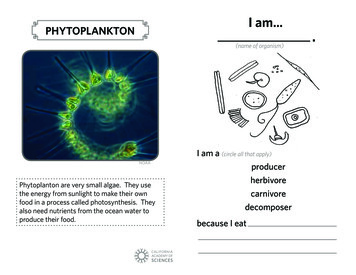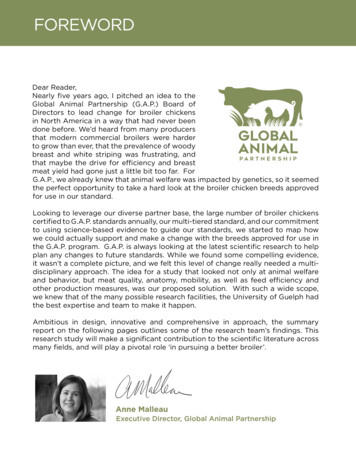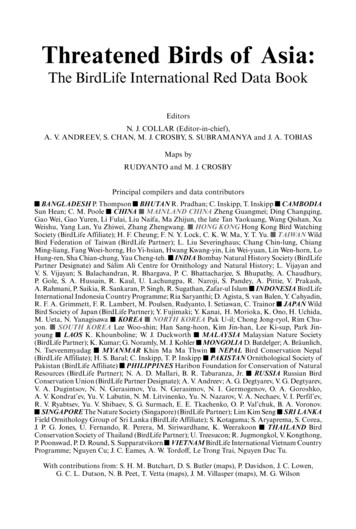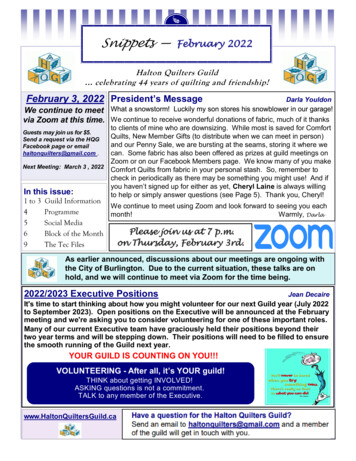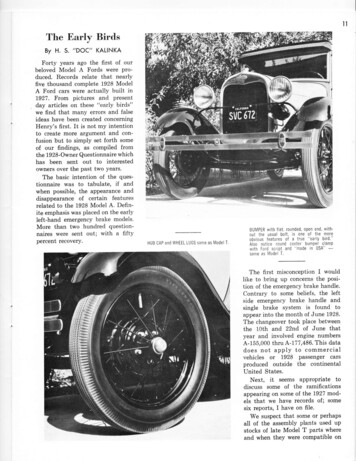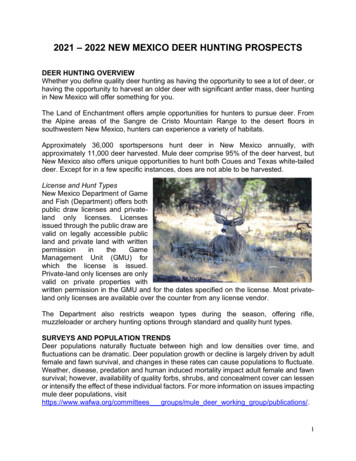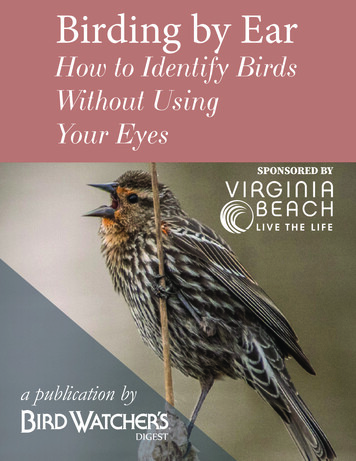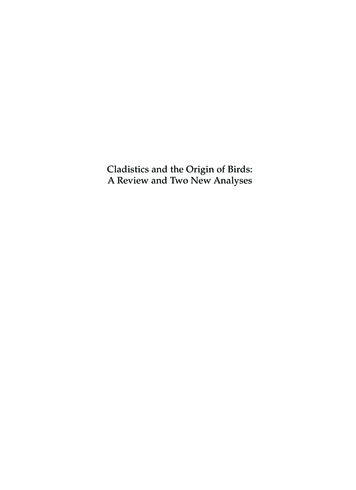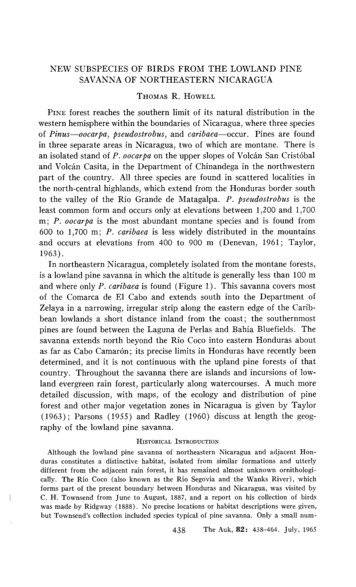
Transcription
NEWSUBSPECIESSAVANNAOF BIRDSFROMTHEOF NORTHEASTERNTHOM SLOWLANDPINENICARAGUAR. HOWELLPINE forest reaches the southern limit of its natural distributionin thewesternhemispherewithin the boundariesof Nicaragua,wherethree speciesof Pinus--oocarpa, pseudostrobus,and caribaea--occur. Pines are foundin threeseparateareasin Nicaragua,two of whichare montane.There isan isolatedstandof P. oocarpaon the upperslopesof VolcanSanCrist6baland Volc/m Casita, in the Departmentof Chinandegain the northwesternpart of the country. All three speciesare found in scatteredlocalitiesinthe north-centralhighlands,whichextendfrom the Hondurasbordersouthto the valley of the Rio Grande de Matagalpa. P. pseudostrobusis theleast commonform and occursonly at elevationsbetween1,200 and 1,700m; P. oocarpais the most abundantmontanespeciesand is found from600 to 1,700 m; P. caribaeais less widely distributedin the mountainsand occursat elevationsfrom 400 to 900 m (Denevan, 1961; Taylor,1963).In northeasternNicaragua,completelyisolatedfromthe montaneforests,is a lowlandpinesavannain whichthe altitudeis generallylessthan 100 mand whereonly P. caribaeais found (Figure 1). This savannacoversmostof the Comarca de E1 Cabo and extendssouth into the Department ofZelaya in a narrowing,irregularstrip alongthe easternedgeof the Caribbean lowlands a short distance inland from the coast; the southernmostpinesare foundbetweenthe Lagunade Perlasand Bahia Bluefields.Thesavannaextendsnorth beyondthe Rio Cocointo easternHondurasaboutas far as CaboCamar6n;its preciselimitsin Hondurashaverecentlybeendetermined,and it is not continuouswith the uplandpine forestsof thatcountry. Throughoutthe savannathereare islandsand incursionsof lowland evergreenrain forest,particularlyalongwatercourses.A muchmoredetaileddiscussion,with maps, of the ecologyand distributionof pineforestand other major vegetationzonesin Nicaraguais given by Taylor(1963); Parsons(1955) and Radley (1960) discussat lengththe geography of the lowland pine savanna.HISTOIlICAI,I TROV JC O Although the lowland pine savanna of northeasternNicaragua and adjacent Honduras constitutes a distinctive habitat, isolated from similar formations and utterlydifferent from the adjacent rain forest, it has remained almost unknown ornithologically. The Rio Coco (also known as the Rio Segovia and the Wanks River), whichforms part of the presentboundarybetweenHondurasand Nicaragua,was visited byC. H. Townsend from June to August, 1887, and a report on his collection of birdswas made by Ridgway (1888). No preciselocationsor habitat descriptionswere given,but Townsend'scollectionincludedspeciestypical of pine savanna. Only a small hum438The Auk, 82:438-464. July, 1965
e 1. Lowland pine savanna about 35 miles northwest of Pue oComar de El bo, i ragua.Photograph taken in February, 1963.Cabezas,ber of each was obtained, however, and many were in poor plumage. The locality wasgiven in Ridgway's paper as the "Segovia River, Honduras," and subsequentchecklists have oftenreferredto this area as "southernHonduras.""EasternHonduras"would be a more accurate designation,and as Townsend's specimensmay have comefrom either bank of the river the records apply to northeastern Nicaragua as well.The English naturalist Merwyn G. Palmer collected some zoological specimens,including birds, along the sameriver in 1905. His bird collectionwas apparently sold to thedealer W. F. H. Rosenberg, and the specimenshave subsequentlybeen dispersedtovarious museumsin Europe and North America. Many years later Palmer describedhis travels in a book, Through unknown Nicaragua (1945). In 1922, J. Fletcher Streetcollectedbirds for one day on the savanna near the town of Prinzapolca (Huber,1932). I know of no other collectionsof birds made in this habitat until my first visitthere in 1955. The professionalcollector W. B. Richardson, who resided in Nicaraguafor much of his life and who obtainedfor British and Americanmuseums most of thebird and mammal specimensfrom that country, never collectedin the lowland pinesavanna.Mention should he made of the great variation in spelling of place names in thesavanna region. Most of the localities are named in the Miskito (Mosquito) Indianlanguage,and mal of the area provide either English or Spanish phonetic approximations. For example,place namesinclude the sound renderedin English as "wa" (i.e.,Waspam); in Spanish,this is rendered as "hua" (Huaspam). As there is no standardization of English or Spanish rendering of sounds in the Miskito language, there areoften several different spellingsof the same place name---i.e., Leimus, Lemus, Laimos,etc. I have attempted to use the spelling most widely acceptedat the locality itself atthe time of my visit, and to place the localities by distance and direction from established communitiessuch as Puerto Cabezasand Waspam.
440Howm; ¾NewSubspecies/romNicaragua[ Vol.Auk82The RobinsonLumber Company of New Orleans,Louisiana,has for many yearsengagedin logging operations in northeastern Nicaragua through a subsidiary, theNicaraguanLong Leaf Pine Lumber Company ("Nipco"), with headquartersin PuertoCabezas.Through the courtesyof the Robinsonfamily and the companypersonnelin Nicaragua, I was able to make collectionsin the lowland pine savannain earlyFebruary, 1955,and in late January and early February of 1962 and 1963. I was accompaniedin 1955 by J. G. Montrello, in 1962 by J. E. Zoeger and O. M. Buchanan,Jr., and by Buchanan in 1963. Studies on the birds and other vertebrates of thisregionare in progress,and the presentpaper dealsonly with thosebirds that appearto represent undescribed forms.ACK OWl.rDO Vlr TSThe study was supportedin large part by Grant no. G 3683 of the National ScienceFoundation.The following institutionsand individualshave been generousin providing specimens on loan and information of many kinds: The American Museum of NaturalHistory (A tN ), Dean Amadon and W. E. Lanyon; United StatesNational Museum(usN t), P.S. Humphrey and G. E. Watson; CarnegieMuseum (c t), A. C. Twomeyand K. C. Parkes; Academy of Natural Sciencesof Philadelphia (ANSP),James Bond;Museum of ComparativeZoology, Harvard University ( tcz), R. A. Paynter,ChicagoNatural History Museum (cNmvr), E. R. Blake; University of Kansas Museumof Zoology (UK), R. F. Johnston; University of Michigan Museum of Zoology(IY tMZ), R. W. Storer; LouisianaState University Museum of Zoology (I.SU), BurrL. Monroe, Jr., and GeorgeH. Lowery, Jr.; Moore Laboratory of Zoology,OccidentalCollege ( I.), J. W. Hardy. The abbreviationin parenthesesfollowing institutionalnamesis that used subsequentlyto indicate the collectionin which particular specimens are located; specimensin the collectionsof the University of California, LosAngeles,are listedas UCI.A. I am grateful to all thosementionedabovefor their assistance and cooperation.I am especiallyappreciativeof the indispensableaid and cooperationof membersofthe Robinsonfamily of New Orleans,La., and the "Nipco" personnelin Nicaragua.Of the latter group, special thanks are due to Mr. William Barry, Mr. and Mrs.Douglas Seale,and Mr. R. M. Abel for their friendly assistancein every possibleway.During an extendedstay in Nicaraguain 1961-62, the staff of the EscuelaNacional deAgriculturay Ganaderiaand its Director, Ing. J. Antonio Mora R., assistedthe fieldwork at every stage. Col. Alfonso Mejia Chamorro, Ministro de la Guerra, Marina yAviaci6n,providedthe necessarypermits with the most cordialefficiency. Srta. ClaraMurphy of La Nica Airlines was especiallyhelpful in expeditingshipmentsof equipment and specimens,and many other Nicaraguan friends provided all manner of aidand information. Lastly, I am particularly grateful to my field companions,O.Buchanan,Jr., and John E. Zoeger,without whoseparticipation this study would nothave been possible.DESCRIPTIONSOE NEWSUBSPECIESSix new subspeciesof birds, all of which are largely or exclusivelyconfined to the lowlandpine savanna,are describedbelow. In the followingaccounts,all measurementsof specimensare in millimeters,all wing measurementsare of the chord,all weightsare in grams,and all namesof colorsthat are capitalizedfollow the systemof Villalobosas modifiedin the
1SA35rLESXZE(3 ), R r0E,MEA r( ), S A mArd)DEVm O r (s )), S Am)Am)ERROROFT E MEAN(SE),ANDCOEFFICIENTOFDIFFERENCE(Cr))FORWIN0 (W)ABIDTAIL (T) co sparverlusnicaraguensistroplcalis6' 6'W9160.3-178.8167.35.631.889 9W9167.9-176.6172.72.740.926 W14168.4-175.3172.22.280.610.529 .711.67Pyrocephalus rubinus6 6 pinicola6 6' blatteus6' 6'6' 6'9 ½Sialia sialiscaribaeameridionalis6' 6'6' 6' ½ 6' 6'6' 6'9 ½ 1.291.070.671.120.72Piranga ]lavasava ar tmfiglinatestaceaalbifacies* In each case comparisonis with the newly-describedsubspecies.A.O.U. Handbook of North American Birds, vol. 1 (Palmer, 1962). Abrief discussionof lighting conditionsunder which colorswere comparedis givenin the Appendixof the presentpaper.When appropriate,measurementsare analyzedstatistically(Table 1)and are alsoexpressedas Dice-squarediagrams(Figures 2-5). The coefficient of difference (C.D.: differencebetween means of two samples/
442HOWELL,New Subspecies) rom Nicaragua[[ Vol.Auk82sumof their standarddeviations)is a statisticproposedby Mayr, Linsley,and Usinger (1953) as an index of the degreeof overlapbetweensamples.Theseauthorssuggesta C.D. value of 1.28 as a minimumfor subspecificrecognitionon the basisof size; they emphasize,however,that this is anarbitrary figure and that biologicaland biogeographicalfactorsmust alsobe given strongconsideration.Faleo sparverius niearaguensis, new subspeciesType.--Adult female, UCL no. 51498, taken 12 miles NW of PuertoCabezas,elevationabout 33 m (100 ft.), Dept. of Zelaya, Nicaragua, on26 January 1962, by O. M. Buchanan,Jr.; weight 79.5 g; largestfollicle3 mm in diameter; original no. 1057.Diagnosis.--Similarto F. s. tropicalisbut smaller (Table 1), with lesssexualdimorphismin colorand size; Tawny (hazel) crownpatch lackingaltogether in males and usually lacking in females (much reduced ifpresent); malesaverageslightly paler than malesof tropicalison crown,back, and wings; femalestend to have increasedamountsof Dark Gray(slate) on wing covertsand to have the dark barring of the scapularsandback reducedand paler, causinga somewhatmasculoidappearance.Measurementsof the type are as follows: wing, 167.9; tail (worn), 104.3;tarsus,32.2; culmen (chord, from cere), 11.6.Range.--Known thus far only from the lowland pine savannaof northeastern Nicaragua from Puerto Cabezasnorthwest to the Rio Coco, butprobablyoccursthroughoutthe savannafrom extremeeasternHondurassouthto the vicinity of the Laguna de Perlas,Nicaragua.Remarks.---Aseries of nine males and nine females was collected in 1962and 1963 at numerouslocalitiesalonga loggingroad that runs throughthesavanna from Puerto Cabezas to the village of Leimus, 15 km west ofWaspam,Comarcade E1 Cabo,on the southbank of the Rio Coco. American Kestrels (a name that I prefer over "SparrowHawk") are abundantin this region,and in February,1963,we estimatedan averageof onebirdseenper odometermile alongthe road. In late Januaryand early February many kestrelswere paired and copulationswere noted frequently; infact, three pairs were collectedimmediatelyafter mating was observed.No nestingactivity wasseen,however,and it appearsthat the time of ourvisitscoincidedwith the earliestpart of the breedingseason.Sizeof testesin malesrangedfrom4 X 2 to 5 x 4 ram,and thelargestfolliclesin femaleswere from 1.0 to 3.0 mm in diameter.In working out the distinctionsbetweenF. s. nicaraguensisand F. s.tropicalisI haveexamineda seriesof 44 birdsidentifiedas the latter subspeciesfrom Chiapas,Guatemala,and Honduras. The followingremarkswill, I hope, serveto clarify the statusof tropicalisas well as that
July596I ]HOWELL,NewSubspecies/romNicaragua443of nicaraguensis.Difficultiesarise,as F. s. sparveriusis a commonmigrantand winter visitant in much of Central America. Specimensfrom CentralAmerica that can be consideredresident birds with reasonablecertaintyare those taken from May into August, and these are mostly birds injuvenal plumageand adults in very worn plumageand/or in molt. Colorand sizecomparisonsof thesespecimenswith thosefrom other populationsmust thereforebe madewith particular care. Confusionhas also resultedfrom certain publishedstatementsand measurements,includingsomeaccompanyingthe original descriptionof F. s. tropicalis,and a brief reviewis in order.Griscom(1930) describedtropicalison the basisof six specimenstakenin late May, 1924, by A. W. Anthonyat Antigua,Chimaltenango,Guatemala,a localitythat is nowa populartouristresortabout 13 mileswestofGuatemalaCity. The confusingstatementthat tropicalis"would appearto be confinedto the arid portion of the Rio Motagua Valley" (thus excludingthe type locality) waslater correctedby Griscom(1932) to "resident in the pine forestsof the Altos of Guatemala,at lower elevations."I haveexaminedthe six birdsof Griscom'soriginalseries,four of whichare at the A VINI-Iand two of whichare now at the cz. Dr. W. E. Lanyonhas kindly providedsupplementalinformationon the rNa series. Thetype of tropicalis( 393671), an adult male,was collectedon 20 Mayand is in very worn body plumagealthoughthe primariesdo not appeartobe heavilyabradedat the tips; the tail is quite worn. My measurementsof this specimenare.' wing, 175.3; tail, 116.8. Friedmann's(1950: 743)wing measurementof 174.5 doubtlessrefersto the type. Griscom(1930),however,gave measurementsfor the wing of malesas 162-171. His seriesincluded"2 ad., 1 imm."; presumablythe type wasoneof the adults,and the other must be ucz 145663, which has a wing measuring171.3.A NI-I 393670, an immaturemalewith the remigesin molt and the longestprimariesincompletelygrown (still ensheathedproximally), has a winglengthof 162. Evidently Griscomgave measurementsfor theselatter twomalesbut somehowneglectedto include the measurementof the type.Griscomgave the wing length for three femalesof F. s. tropicalisas173-182. A H393669, an immature female, has a wing length of 171(Lanyon, in litt.), but the remigesare in a stageof molt similar to that ofthe immature male mentionedabove. This specimenmust be the basisforGriscom'sfigureof 173 as the low extreme,becauseneitherthe singleadultfemalein the originalseriesnor any taken subsequentlyhas a wing lengthof lessthan 178. A NI-I 393672, a youngfemale,has remigesthat are onlypartly grown and the wing measuresonly 125. Mcz 145664, an adultfemale,has a wing length of 180.0 accordingto my measurements,and thisis reasonablycloseto Griscom'smaximum figure of 182.
444HOWELL,New Subspecies[rom Nicaragua[ Auk82[ Vol.Bond (1943), in his extensivereviewof variationin Falco.sparverius,points out that wing length is the most reliable measurementindicative ofsizein this species.Bond foundno significantdifferencein wing lengthbetweenimmaturesand adults,and he stressedthe generalunreliabilityoftail, tarsus,and beak measurements.I have thereforeconsideredwinglength as the most important mensuralcharacter. Out of the seriesof 44birdsidentifiedas F. s. tropicalis,thereare 14 malesand 7 females,collectedfrom May throughAugust,fromwhichreliablewing measurementsmaybe obtained;theseare includedin Table 1 (seebelowfor explanationof the number10 givenfor the sampleof females).The series of males includes both immatures and adults that have mea-surementswithin 1 mm of the maximumand minimumfigures,and theseriesof sevenfemalesincludesfour birdsthat may be immaturesand three(includingthe smallestand largestones) that are adult or subadult. Thesampleswerethereforenot dividedinto agegroups.The largestbird (½ 135211,female,wing 189.6) wastakenat Siguatepeque,Comayagua,Honduras,on31 July 1951. It wasacquiringfreshplumage;theinnerprimariesare freshlygrownin and the outermost,olderones,includingthe longest,are only slightlyworn. Both the date of collectionand the stageof moltindicatestronglythat this was a residentbird and not a migrant.Swann(1920) describeda subspeciesF. s. guatemalensisand designatedas the type a specimenfrom Capetillo,Sacatepequez,Guatemala.This isnow ½z 92772. Griscom(1930) and Bangs (1930) stated that Swann'stype was a migrant F. s. sparveriusbut did not discussthe basisof theidentification.Dr. R. A. Paynter has reexaminedthis specimenand informsme that there is no date or sexon the originallabel, but that the birdis an immaturemale with someTawny on the crownand a flat wing measurementof 190 mm. This figureconfirmsthe opinionthat the specimendoesnot representthe small residentform, althoughanother bird ( cz92774; seebelow)in Swann'sseriesfrom Capetilloseemsto be an exampleof F. s. tropicalis.Griscom's(1930) descriptionof color in tropicaliswas basedon a fewworn and immaturespecimens,and examinationof a larger seriesrequiressomechanges.The followingredefinition is a slight modification of thatof Friedmann (1950). Comparedwith F. s. sparverius,tropicalisaveragesdarkerdorsallyin both sexes,matchingthe darkerexamplesof sparverius.In adult malesthe chestis Cinnamon(fawn) and is largelyor completelyunstreaked; the underparts are never uniformly Cinnamon as in someexamplesof F. s. sparverius.Immature maleslack most or all of the Cinnamon on the chest,and are finely streakedin this area. In males of allagesthe throat is white and the rest of the underpartsare white or whitishwashedwithpaleCinnamon,alwayswitha variablebutmoderatequantity
July1965 ]HOW ;LL,NewSubspecles) romNicaragua445of black spotson the upper abdomenand flanks. The Tawny crownpatchis absentin only about one-thirdof the males (6 of 19) and its presenceorabsenceis not correlated with age. In some males the Tawny coloris presentonly as a trace. All femalesof all ageshave at least a trace ofTawny in the crown. The darknessof the ventral stripingin femalesvariesindividually, and in most it is no darker than the usual conditionin F. s.sparverius.Hellmayr and Conover (1949: 326) listed four specimensfrom Guate-mala in the Field (Chicago) Museum collectionand commentedthat"Griscom'smeasurementsfor the males are below normal, as shownin ourspecimens";they gave the wing length as 180 to 185. I have examinedthesespecimens,whichare all males. One from Acatenango,Chimaltenango,has a wing measuring192.4; this bird is referable to F. s. sparverius,andits wing measurementwas evidentlyomitted for that reasonby Hellmayrand Conover,althoughthe specimenwas inadvertentlyincludedin the listof tropicalisexamined. The other three birds are larger than any summertaken tropicalismales and are within the size range of F. s. sparveriusasgiven by Bond (1943) and Friedmann (1950). C n r 22387 from Tecpam(Tecpdrn),Sololg, 12 April 1906, wing 179.3, is very dark dorsally, hasno Tawny crown patch, and may be a large example of F. s. tropicalis.CtaH r 23334,SierraSta. Elena, Sololaf,15 December1905,wing 180.6,hasno Tawny crown patch and is probably a juvenal as it has heavy blackbarring dorsally and heavy black streaking on the chest; ctaH r 93603,Volcgn Tajamulco, San Marcos, 21 February 1934, wing 184.5, has someTawny in the crownand is not very dark dorsally. These latter two birdsare probably migrant sparverius,but none of thesesubspecificidentifications can be considered certain.Of six other males in the seriesbefore me, taken in Guatemala andHondurasfrom Septemberto April, threecan be assignedto tropicaliswithreasonablecertainty. Theseare USN r348058, Subirana,Yoro, Honduras,31 January 1933, wing 168.0; rcz 193518, 7 mi. SE of San Jer6nimo,elevation 3,300 ft., Baja Vera Paz, Guatemala,10 January 1959, wing 176.0;and v r rz 155237,5 mi. S. San Jer6nimo,3,200 ft., Baja Vera Paz, Guatemala, 29 September 1958 (tenth and ninth primaries in molt; eighth,166.0). Usta r 396541, San Josd,Guatemala, 2 April 1947, weighed 115and has a wing length of 187.0; it belongswith F. s. sparverius.The remaining two have identical wing lengths--179.5--but are very differentin color. AtasP63645, Quirigug,Izabal, Guatemala,4 April 1915, is uniform Cinnamonover the entire underparts,with virtually no streaks orspots. Usta r 150764, Villa Nueva, Guatemala, 10 December 1890, isclear, unstreakedCinnamon on the breast only, with the rest of the underpartswhitish with a moderateamount of black spottingon the upper
446HowE[I,NewSubspecies/tomNicaragua[ Vol.Auk82abdomenand flanks. As the Quirigua bird resemblesin color many examplesof F. s. sparveriusbut is unlike any specimenof unquestionabletropicalis,I place it with the former subspecies.The Villa Nueva birdmatchestropicalisin color extremely well and I regard it as probably,but not certainly, tropicalis.There are six femalesin the seriesbesidesthe sevensummer-takenbirds,but only two of thesehave a date on the label. These two are both fromTegucigalpa,Honduras--Mcz 198252, 11 September1937,wing 192.8,andMCZ198253,28 October1937,wing 188.0. I placethe formerwith sparverius on the basis of large size and coloration that matches that sub-species;the latter bird probablyrepresentssparveriusalso,but it is slightlysmallerand darker and could representtropicalis. Two othersare fromCapetillo,Guatemala( cz 92773 and 92774, wings 187.5 and 182.8), andtwo are from Utiles Rock, Guatemala (USAM 103352 and 103353, wings182.0 and 177.8). Both the latter have fresh remiges,with light tips stillpresent,and they may be placedwith tropicaliswith reasonableassuranceas they match femalesof that subspeciesin color as well as size. Mcz92774 from Capetillofits well with tropicalisin colorand size and may bereferredto that subspecies.Mcz 92773 I am unableto placedefinitelyasit is very pale dorsally,with all the colorsdiluted,and has a wing lengthin the zoneof overlapbetweentropicalisand sparverius.A reexaminationof the sevenmales and nine femalesof F. s. sparveriusfrom El Salvadorthat are now in the Dickey Collection,U.C.L.A., confirmsvan Rossem'sstatementthat noneof theseis referableto tropicalis (Dickeyand van Rossem,1938).The characteristicsof F. s. nicaraguensiscan now be comparedwiththoseof tropicalisin greater detail. F. s. nicaraguensisaveragesslightlypaler dorsally in both sexes. In males, the crown and wing covertsareusuallylighter and the back is lessdeeplyTawny. The back colorin nica-raguensiscontrastswith the Tawny Chestnutof the upper surfaceof therectrices;in tropicalisthe back is often concolorwith the tail. Femalesofnicaraguensisusually have the dark barring of the back reducedand alsopaler, approachingDark Gray rather than BlackishGray or Black. Onlyone female out of nine is as dark dorsally as tropicalis. Six of the ninemales of nicaraguensishave unstreaked, Cinnamon-coloredchests; twoothershave a washof Cinnamonand a slight amount of streaking,and athird has only a tinge of Cinnamon color and moderatestreaking on thechest. In my seriesof nicarague'nsis,noneof the nine maleshas any traceof Tawny in the crown. Two of the femaleshave a small Tawny crownpatch, and one other has a few partly Tawny feathersin the crown. Theother six femaleshave gray crownslike the males. The tendencytowarda masculoidcolorpattern in femalesis most marked in UCLA51497, which
July1965 elis I0Figure 2. Wing lengthsof FaIco sparveriusnicaraguensisand F. s. tropicaiis. Thehorizontallines representthe range of the sample; vertical lines representthe samplemean. The distancefrom the outer end of the dark rectanglesto the mean equalsthevalue of one standard deviation; the distancefrom the outer end of the white rectanglesto the mean equalsthe value of twice the standard error of the mean.has the barringof the scapularsand back reducedconsiderablyand haslargelyMedium to Dark Gray wing convertsand very narrowstreakingon the underparts.This bird wasoneof a matedpair collectedon 26 January 1962.The reductionin color dimorphismin nicaraguensisis paralleledby areduceddifferencein size betweenthe sexes.Five malesweighed63.0,73.0, 76.0, 76.8,and 78.0,and five femaleswererecordedas weighing75.0,78.0, 79.5, 85.0, and 87.6. The longest-wingedmale (178.8) in the seriesof nicaraguensisexceedsthe longest-wingedfemale(176.6) in this dimension. Nicaraguensisaveragessmallerthan any of the other subspeciesofNorth and Middle Americaexceptfor caribaearumof Puerto Rico and theLesserAntilles. In color pattern, however,nicaraguensisshowsno closeresemblance to the West Indian forms and its closest affinities seem to bewith tropicalis. In Figure 2, wing lengthsof both sexesof nicaraguensisand tropicalis are compared. Only the measurementsof summer-takentropicalismales are utilized; the figureswould be somewhathigher ifwinter-taken "probable" tro icalis were included. The measurementsofthreeundatedfemalespecimensthat appearto representtropicalisare includedas their wing lengthsfall well within the extremesshownby thesummer-takenfemales. The differencein mean wing length in the malesis not quite significant, but the difference between the females is muchgreaterand in the presentseriesthere is no overlap. The lesserdegreeofdifferencebetweenthe sexesin nicaraguensisas comparedwith tropicalisis also evident.The remigesof severalbirds in the seriesof nicaraguensisare somewhatworn, but in even the most worn specimensthe extent of abrasionis not
448HOWELL,NewSubspeciesfromNicaragua82[ Vol.Aukgreat enoughto accountfor the relatively short measurements.Both thesmallestand the largestmalesof nicaraguensisare in presumablysubadultplumage as they have streaked chests. The remigesof the smallestbirdappearto be moderatelyworn,but the next smallest,an unwornadult male,hasa wing measuringonly 1.4 mm longer. The male with the longestwingseemsunusuallylarge, as its measurementis 7 mm longerthan that of thenext largestmale; in fact, only two of the nine maleshave wing lengthsgreaterthan 170. The type happensto have the shortestwing of any of thefemales,but the primariesof this bird appearto be quite freshand unworn.This specimen,whichwasoneof a matedpair, was chosenas the type becauseof its excellentplumageconditionand its exemplificationof the colorcharacteristicsof nicaraguensis;thesefactors,it is felt, outweighthe possible disadvantagesof choosinga type with the shortestwing of the series.The vocalizationsand behaviorof nicaraguensisare evidentlylike thoseof F. s. sparveriusandpresumablythoseof otherNorth and CentralAmerican forms. It is of interestthat F. s. sparveriusis a commonmigrant andwinter visitant on the Pacific slopeof Nicaragua, where there is no resident form, but is much scarceron the Caribbeanslope. There is hardlyany open habitat suitablefor kestrelson the Caribbeanslopeexcept thepine savanna,where nicaraguensisis presumablyresident. One specimenof F. s. sparveriuswas collectedby M. G. Palmer at Sacklin (Saclin),Comarca de E1 Cabo, Nicaragua, on 22 February 1905 (AMNH 393223).This bird is an immature male with much Tawny in the crown and a winglength of 186. No other specimensof F. s. sparveriushave been takenwithin the rangeof nicaraguensis,but we observeda large femalekestrelthat was almostsurelysparvcriusin the town of Puerto Cabezasin January and February, 1962. It is tempting to suggestthat wintering F. s.sparveriusare rare in the pine savannabecauseof inability to competesuccessfullyin that habitat with nicaraguensis,but there are insufficientdatato supportor refute this speculation.The larger F. s. sparveriuswouldpresumablybe at an advantagein direct conflictswith nicaraguensis,butthe smallerform might gain throughmoreeffectiveexploitationof the apparently limited foodresourcesof the savanna.The breedingpopulationsof kestrelsin Central America from Chiapassouthappearto be restrictedto pine forests,and nicaraguensisis probablyderived from a montane,tropicalis-likepopulationthat establisheditselfin the lowlandpine savanna. Althoughthis new form representsa southward extensionof the known breeding range of the species,there is stilla wide gap betweenthe rangeof nicaraguensisand that of the closestmainland populationsof F. sparveriusin northernSouth America.
July1965 ]HOWELL,NewSubspeciesfromNicaragua449Amazilia cyanocephalachlorostephana, new subspeciesType.--Adult female, UCLAno. 51577, taken 15 kilometersSSW ofWaspam,elevationabout 33 m (100 ft.), Comarcade E1 Cabo,Nicaragua,on 3 February 1962, by Thomas R. Howell; eggwithout shell in ovidnet;original no. 2278.Diagnosis.--Similarto Amazilia cyanocephalaguatemalensisbut withthe crown glittering Green instead of Cobalt Ultramarine (blue); sizesmaller. Measurementsof the type are as follows:wing, 54.1; tail, 28.8;culmenfrom nostril, 16.3.Range.--Known thus far only from the lowlandpine savannaand edgeof adjacentbroad-leavedforestof northeasternNicaragua from the vicinityof Puerto Cabezasnorthwestto the Rio Coco,but probablyoccursthroughout the savanna from extreme eastern Honduras to the vicinity of theLaguna de Perlas, Nicaragua.Remarks.---Aseriesof six malesand eight femaleswas collectedin lateJanuaryand early Feb
Jr., and by Buchanan in 1963. Studies on the birds and other vertebrates of this region are in progress, and the present paper deals only with those birds that appear to represent undescribed forms. ACK OWl. rDO Vlr TS The study was supported in large part by Grant no. G 3683 of the National Science Foundation.
